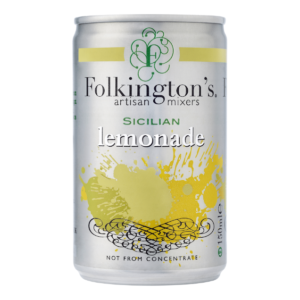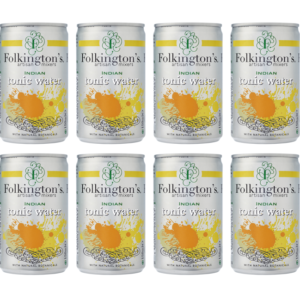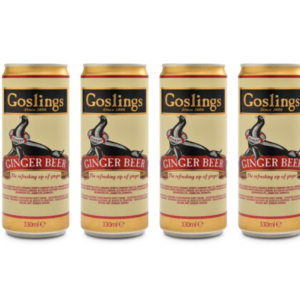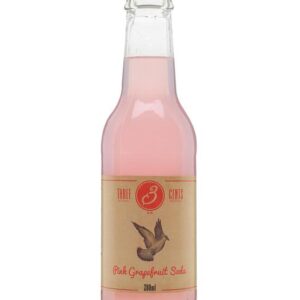Showing all 4 resultsSorted by popularity
Mixer/Tonic – The Complete Guide
TL;DR: Quick Overview
- Mixers/Tonics are characterized by their ability to enhance and complement spirits without overpowering them
- Primarily made from carbonated water, sweeteners, and natural flavorings, defined by unique botanical infusions
- Available in various styles including classic tonic water, ginger beer, and flavored sodas
- Best enjoyed chilled, in proper ratios with spirits, and can be experienced in a Gin & Tonic or Moscow Mule
Disclaimer: This guide is intended for informational purposes for adults over 18 years of age. Vault of Spirits encourages responsible alcohol consumption.
Introduction to Mixers/Tonics
Mixers and tonics have a rich history and fascinating craft behind them. From their origins in colonial settings to their global popularity today, these enhancers have evolved to become some of the world’s most essential cocktail companions.
This guide provides insight into the production, flavor profiles, and enjoyment of mixers and tonics, whether you’re a beginner or experienced enthusiast.
How Did Mixers/Tonics Originate?
From Past to Present
The history of mixers dates back to the 18th century, with tonic water being one of the earliest examples.
Originally developed by the British in colonial India, tonic water contained quinine from cinchona bark as a treatment for malaria.
The bitter taste of quinine led British officers to mix it with gin and lime, inadvertently creating the now-classic Gin & Tonic.
Meanwhile, other mixers like ginger beer emerged from traditional fermentation practices in the Caribbean and England in the mid-1700s.
Which Historical Milestones Shaped Mixers/Tonics?
The commercial production of soda water began in the late 1700s, revolutionizing the beverage industry.
Schweppes, founded in 1783, became one of the first companies to mass-produce carbonated beverages, including tonic water.
The invention of industrial carbonation methods in the 19th century allowed for wider distribution and variety of mixers.
Prohibition in the United States (1920-1933) actually boosted mixer innovation, as people needed ways to mask the harsh taste of bootleg spirits.
How Have Mixers/Tonics Influenced Cultural Traditions?
In British colonial culture, the daily “sundowner” ritual centered around the Gin & Tonic, becoming a symbol of colonial lifestyle.
In America, the soda fountain became a cultural institution in the early 20th century, where mixers and syrups were crafted with artistic flair.
The Moscow Mule, created in 1941 with ginger beer, helped popularize vodka in America, demonstrating the cultural influence of mixers.
Today, local mixers reflect cultural preferences worldwide – from bitter Italian sodas to sweet Japanese ramune.
Why Are Mixers/Tonics Popular Today?
The craft cocktail renaissance has elevated mixers from afterthoughts to essential cocktail elements.
Premium artisanal tonics and mixers have emerged, featuring natural ingredients and sophisticated flavor profiles.
Health-conscious consumers appreciate lower-sugar options and natural botanical infusions.
The versatility of mixers allows both professional bartenders and home enthusiasts to create complex flavors without extensive training.
How Are Mixers/Tonics Produced?
Which Raw Materials Are Used in Production?
The foundation of most mixers begins with purified water, which provides the canvas for other flavors.
High-quality mixers often use natural sweeteners like cane sugar, honey, or agave nectar rather than artificial alternatives.
Botanical elements provide the distinctive character that separates premium mixers from generic options.
- Quinine – The bitter compound from cinchona bark that gives tonic water its distinctive flavor
- Citrus oils – Provide brightness and aromatic complexity to many mixers
- Herbs and spices – Elements like ginger, cardamom, and lemongrass add depth and complexity
How Does the Carbonation Process Work?
Modern carbonation typically involves dissolving carbon dioxide under pressure into the liquid mixture.
The level of carbonation varies significantly between mixers – tonic water typically has sharper carbonation than ginger ale.
Artisanal producers may use traditional methods like bottle fermentation to create natural carbonation, particularly in ginger beer.
The size and persistence of bubbles affect both mouthfeel and how the mixer interacts with spirits.
Which Production Techniques Are Used?
Production methods vary widely depending on the type of mixer and manufacturer.
- Infusion – Steeping botanicals in water to extract flavors, creating complex and nuanced profiles
- Cold compounding – Mixing flavor essences and extracts without heat to preserve volatile compounds
- Fermentation – Used primarily for traditional ginger beer, creating depth through natural microbial processes
What Significance Does Filtering Have?
Filtering is crucial to remove particulate matter from botanical infusions while preserving flavor.
Premium mixers often employ multiple filtration stages to achieve clarity without stripping away essential oils.
Some artisanal producers deliberately leave minute botanical particles to signify natural ingredients and minimal processing.
The water source itself is often filtered through advanced systems to ensure purity as the foundation of the product.
Which Regions Are Known for Mixers/Tonics?
Where Are the Best Varieties Produced?
The United Kingdom has a long history of tonic production, with brands like Fever-Tree and Fentimans leading the premium market.
Spain has developed distinctive tonics with Mediterranean botanicals that pair perfectly with their gin-centric drinking culture.
The United States has seen an explosion of craft mixer companies in regions like the Pacific Northwest and New England.
Mexico produces exceptional ginger beers and unique mixers incorporating indigenous ingredients like hibiscus and tamarind.
How Do Geography and Climate Affect Taste?
Water source significantly impacts mixer quality – regions with exceptional water often produce superior mixers.
Climate affects the quality and availability of botanical ingredients, with tropical regions offering access to fresh ginger and exotic fruits.
Cultural drinking traditions shape regional preferences for sweetness, bitterness, and carbonation levels.
Local agricultural practices influence which ingredients become signature components in regional mixer styles.
What New Trends Are Emerging in Mixer Production?
Low or zero-calorie mixers using natural sweeteners like stevia and monk fruit are gaining popularity.
Functional mixers incorporating adaptogens, CBD, or probiotics target health-conscious consumers.
Single-estate tonics, where ingredients come from one specific location, appeal to terroir-focused enthusiasts.
Sustainability has become a major focus, with brands emphasizing organic ingredients, plastic-free packaging, and carbon-neutral production.
What Do Different Quality Designations Mean?
The term “premium” usually indicates natural ingredients rather than artificial flavors or sweeteners.
“Craft” typically suggests small-batch production with attention to ingredient sourcing and production methods.
“Botanical” mixers emphasize plant-derived flavors rather than synthetic alternatives.
“Artisanal” generally implies traditional production methods and often hand-crafted elements in the process.
How Do Mixers/Tonics Taste?
What Characterizes the Typical Flavor Profile?
The ideal mixer balances sweetness with complexity, providing enough character to enhance a spirit without dominating it.
Carbonation level affects both mouthfeel and flavor release, with proper effervescence cleansing the palate between sips.
Quality mixers feature a clean finish rather than lingering artificial sweetness.
- Primary Flavors – Citrus, bitterness, sweetness, and spice form the foundation
- Botanical Notes – Floral, herbal, and woody elements provide complexity
- Texture Elements – Effervescence, viscosity, and finish complete the experience
How Does Taste Vary Between Different Styles?
Classic tonic water offers bitterness from quinine balanced with sweetness and subtle citrus notes.
Ginger beer provides spicy heat, natural sweetness, and often lemon notes with a warming sensation.
Club soda is neutral with clean effervescence, designed to highlight rather than alter a spirit’s character.
Flavored sodas range from subtle enhancements like elderflower to bold profiles like bitter lemon or blood orange.
How Does Flavor Develop After Production?
Unlike spirits, most mixers don’t improve with age and should be consumed relatively fresh.
Exposure to light can deteriorate botanical elements, particularly in naturally flavored products.
Temperature fluctuations can affect carbonation levels and the stability of natural flavors.
Some fermented mixers like traditional ginger beer continue to develop complexity if properly stored.
What Signs Reveal High Quality?
Fine, persistent bubbles indicate proper carbonation technique rather than forced, aggressive fizz.
Natural cloudiness in some products (like traditional ginger beer) can signal minimal filtering and authentic production.
Aromatics should be pronounced but balanced, showcasing botanical complexity rather than artificial uniformity.
The ingredient list should be relatively short and feature recognizable components rather than chemical stabilizers and artificial flavors.
How Are Mixers/Tonics Best Enjoyed?
What Is the Optimal Serving Method?
Always serve mixers well-chilled to maintain carbonation and enhance flavor clarity.
Pour mixers slowly down the side of the glass to preserve bubbles and prevent excessive foaming.
Add mixers after the spirit and ice to allow proper integration without diluting the carbonation.
The ratio between spirit and mixer is crucial – typically 1:3 for tonic water and 1:2 for ginger beer.
Which Glass and Temperature Are Ideal?
Highball glasses are standard for most mixed drinks, providing enough volume for proper ratios.
Balloon glasses or copa glasses are ideal for gin and tonic, capturing aromatic elements above the drink.
Copper mugs for Moscow Mules maintain temperature and enhance the sensory experience.
Serve mixers at 38-45°F (3-7°C) for optimal flavor release and carbonation preservation.
How Do You Taste Like an Expert?
First, taste the mixer alone to assess its inherent qualities before combining with spirits.
Note the initial sweetness or bitterness, followed by the mid-palate complexity and finish.
Evaluate carbonation level by observing bubble size, persistence, and mouthfeel.
Consider versatility – how the mixer might pair with different spirits beyond its traditional applications.
Which Foods Complement Mixers/Tonics?
Citrus-forward tonics pair beautifully with seafood, particularly oysters and light fish dishes.
Spicy ginger beer complements Asian cuisine, especially dishes with similar ginger notes.
Bitter tonics cut through the richness of charcuterie and aged cheeses.
Herbal mixers enhance the flavors of Mediterranean appetizers like olives and tapas.
Which Cocktails Can Be Made with Mixers/Tonics?
Which Classic Cocktails Should You Know?
The most iconic mixer-based cocktails have stood the test of time through perfect balance and simplicity.
Gin & Tonic
- Ingredients: 2 oz gin, 4-5 oz tonic water, lime wedge
- Preparation: Build in a copa or highball glass over ice, garnish with lime
- History: Created by British officers in India who mixed quinine tonic with gin to make the medicine more palatable
Moscow Mule
- Ingredients: 2 oz vodka, 4-6 oz ginger beer, lime juice
- Preparation: Build in a copper mug with ice, garnish with lime wedge
- History: Created in 1941 to help sell vodka and ginger beer in America, popularized by the distinctive copper mug
Which Modern Cocktails Are Worth Trying?
Contemporary mixologists have created innovative drinks that showcase the versatility of quality mixers.
Elderflower Collins
A refreshing combination of gin, lemon juice, elderflower tonic, and fresh herbs that highlights floral notes.
Spiced Rum & Ginger
Spiced rum paired with premium ginger beer and a dash of Angostura bitters creates complex layers of warmth and spice.
Mediterranean Tonic Spritz
White port or vermouth combined with Mediterranean-style tonic water and citrus offers a lower-alcohol alternative to traditional spritzes.
How Are Mixers Enjoyed on Their Own?
Premium mixers are increasingly consumed as sophisticated non-alcoholic options in their own right.
Tonic water served with fresh herbs and citrus makes an elegant alcohol-free aperitif.
Artisanal ginger beer with fresh lime offers complexity without alcohol.
Many premium mixer producers now specifically market their products for both mixed and standalone consumption.
Which Homemade Variations Can You Experiment With?
Creating custom infused simple syrups allows for personalized mixer creations when combined with soda water.
Homemade ginger syrup mixed with carbonated water offers fresh intensity commercial products can’t match.
Citrus cordials from fresh fruit and peels provide bright, authentic flavors for custom mixers.
Herbal infusions like rosemary, lavender, or basil can be added to basic mixers for signature flavor combinations.
What Should You Know Before Buying Mixers/Tonics?
Which Details Should You Look For When Purchasing?
Check ingredient lists for natural components rather than artificial flavors or high-fructose corn syrup.
Look for appropriate carbonation levels based on intended use – higher for standalone sipping, medium for most cocktails.
Consider bottle size – smaller formats ensure freshness as carbonation and flavor deteriorate after opening.
Glass bottles generally preserve flavor better than plastic, though they’re less practical for certain situations.
What Do You Get for Your Money in Different Price Ranges?
Basic mixers ($1-3) typically contain artificial flavors, more sugar, and aggressive carbonation.
Mid-range options ($3-5) often feature natural ingredients but may still include some preservatives.
Premium mixers ($5-8) use high-quality natural ingredients, balanced formulations, and often feature unique botanical blends.
Ultra-premium options ($8+) may include rare ingredients, small-batch production, and exceptional water sources.
How Are Mixers/Tonics Properly Stored?
Always refrigerate after opening to maintain carbonation and flavor freshness.
Store unopened mixers in a cool, dark place away from direct sunlight which can degrade flavors.
Use within 1-3 days of opening for optimal carbonation and flavor.
Never freeze carbonated mixers as this will destroy the carbonation and potentially cause containers to burst.
Are Mixers/Tonics a Good Investment?
Unlike spirits, mixers are generally not collectible or investment-worthy due to their limited shelf life.
The real investment is in quality – premium mixers can dramatically improve cocktail experiences without the cost of ultra-premium spirits.
Some limited edition or seasonal releases from premium brands may become collector’s items, but primarily for display rather than consumption.
Investing in knowledge about quality mixers often yields better cocktails than simply buying expensive spirits.
Which Brands Do We Recommend?
What’s Best for Beginners?
Fever-Tree offers a widely available entry point to premium mixers with their range of tonics and ginger products.
Q Mixers provides balanced, not-too-sweet options that work well with a variety of spirits.
Fentimans offers traditionally brewed products with distinctive flavor profiles that showcase what quality mixers can be.
East Imperial provides historically inspired tonics that highlight how mixer quality can transform a simple cocktail.
What Will Impress Enthusiasts?
Artisanal brands like Jack Rudy offer small-batch tonic syrups that allow for customized carbonation and strength.
Bradley’s Kina Tonic features higher quinine content and complex botanicals for a more authentic colonial-style experience.
Merchant’s Heart approaches mixer development with a flavor-first methodology, creating “spirit enhancers” rather than mere mixers.
1724 Tonic Water, named for the altitude at which its quinine is harvested in the Andes, offers exceptional terroir-driven flavor.
Which Bottles Are Most Sought After?
Limited edition seasonal releases from Fever-Tree, featuring unique botanicals, often sell out quickly.
Jeffrey’s Tonic Syrups in unusual flavors like Yarrow, Rosehip & Indian Tonic attract collectors and enthusiasts.
Collaboration mixers between premium brands and famous bars or mixologists create sought-after limited runs.
Extremely small-batch producers like Bermondsey Tonic Water, with their hand-labeled bottles, generate cult followings.
Where Do You Get the Most Value for Money?
Double Dutch provides excellent quality at slightly lower price points than some premium competitors.
Fever-Tree’s larger format bottles offer better value for frequent consumption.
Tonic syrups like Jack Rudy or Bradley’s offer excellent value as they can be diluted to taste and maintain freshness longer.
Store brands from premium grocers like Whole Foods or Waitrose often provide surprisingly good quality at reasonable prices.
Frequently Asked Questions
What Are Mixers/Tonics?
Mixers and tonics are non-alcoholic beverages specifically designed to complement and enhance spirits in cocktails.
They typically contain carbonated water, natural or artificial flavorings, sweeteners, and sometimes functional ingredients like quinine in tonic water.
Quality mixers balance flavor complexity with the ability to highlight rather than mask the characteristics of the spirits they accompany.
How Are Mixers/Tonics Produced?
Production begins with a base of purified water, to which sweeteners and flavorings are added according to proprietary recipes.
Botanical ingredients may be infused, distilled, or extracted to create complex flavor profiles.
The mixture is then carbonated under pressure and bottled or canned for distribution.
Premium producers often use cold-filtration processes to preserve delicate flavors that might be damaged by heat.
What Characterizes Mixers/Tonics?
Quality mixers feature balanced sweetness, appropriate carbonation, and authentic flavors derived from natural ingredients.
They complement rather than overwhelm spirits, enhancing the drinking experience through thoughtful flavor pairing.
Different styles offer varying levels of sweetness, bitterness, spice, and botanical complexity to suit different spirits and preferences.
Where Can You Buy Mixers/Tonics?
Premium supermarkets typically stock a selection of quality mixers in their beverage or spirits sections.
Specialty liquor stores often carry curated selections of artisanal and craft mixers.
Online retailers like Amazon, Master of Malt, and The Whisky Exchange offer extensive selections with detailed descriptions.
Direct purchasing from mixer companies’ websites often provides access to limited editions or full product ranges not available elsewhere.



